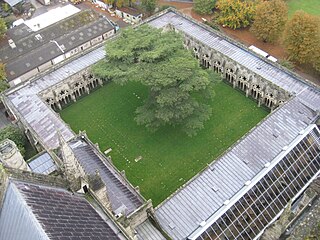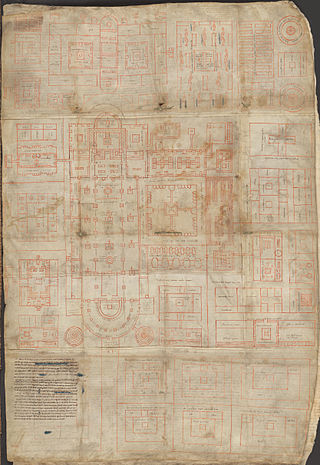
The Abbey of Saint Gall is a dissolved abbey (747–1805) in a Catholic religious complex in the city of St. Gallen in Switzerland. The Carolingian-era monastery existed from 719, founded by Saint Othmar on the spot where Saint Gall had erected his hermitage. It became an independent principality between 9th and 13th centuries, and was for many centuries one of the chief Benedictine abbeys in Europe. The library of the Abbey is one of the oldest monastic libraries in the world.

Gall according to hagiographic tradition was a disciple and one of the traditional twelve companions of Columbanus on his mission from Ireland to the continent. However, he may have originally come from the border region between Lorraine and Alemannia and only met Columbanus at the monastery of Luxeuil in the Vosges. Gall is known as a representative of the Irish monastic tradition. The Abbey of Saint Gall in the city of Saint Gallen, Switzerland was built upon his original hermitage. Deicolus was the elder brother of Gall.

A cloister is a covered walk, open gallery, or open arcade running along the walls of buildings and forming a quadrangle or garth. The attachment of a cloister to a cathedral or church, commonly against a warm southern flank, usually indicates that it is part of a monastic foundation, "forming a continuous and solid architectural barrier... that effectively separates the world of the monks from that of the serfs and workmen, whose lives and works went forward outside and around the cloister."

Paschasius Radbertus (785–865) was a Carolingian theologian and the abbot of Corbie, a monastery in Picardy founded in 657 or 660 by the queen regent Bathilde with a founding community of monks from Luxeuil Abbey. His most well-known and influential work is an exposition on the nature of the Eucharist written around 831, entitled De Corpore et Sanguine Domini. He was canonized in 1073 by Pope Gregory VII. His feast day is 26 April.

Notker the Stammerer, Notker Balbulus, or simply Notker, was a Benedictine monk at the Abbey of Saint Gall active as a composer, poet and scholar. Described as "a significant figure in the Western Church", Notker made substantial contributions to both the music and literature of his time. He is usually credited with two major works of the Carolingian period: the Liber Hymnorum, which includes an important collection of early musical sequences, and an early biography of Charlemagne, the Gesta Karoli Magni. His other works include a biography of Saint Gall known as the Vita Sancti Galli and a martyrology, among others.

Adalard of Corbie was the son of Bernard who was the son of Charles Martel and half-brother of Pepin; Charlemagne was his cousin. He is recognised as a saint within the Roman Catholic and Eastern Orthodox Church.
Notker or Notger is a masculine Germanic given name. Notable people with the given name include:

The Plan of Saint Gall is a medieval architectural drawing of a monastic compound dating from 820–830 AD. It depicts an entire Benedictine monastic compound, including church, houses, stables, kitchens, workshops, brewery, infirmary, and a special building for bloodletting. According to calculations based on the manuscript's tituli the complex was meant to house about 110 monks, 115 lay visitors, and 150 craftmen and agricultural workers.
Ekkehard is a German given name. It is composed of the elements ekke "edge, blade; sword" and hart "brave; hardy". Variant forms include Eckard, Eckhard, Eckhart, Eckart. The Anglo-Saxon form of the name was Ecgheard, possibly attested in the toponym Eggerton.
Vorster is a surname. Notable people with the surname include:
Ó Cuindlis was the name of an Irish family of brehons and scholars from Uí Maine, located in present-day County Galway and County Roscommon, in Connacht. It means 'Descendant of Cuindleas'. It was also spelt with Cuindilis and Cuindleas, later Cuinnlis and Coinlis, and in County Mayo Coinleisc and Coinlisc. The earliest form of the name can be traced back to an abbot from the 8th century, named Cuindles.
Cumméne, also spelled Cuimín, Cummin, Cumin etc., is an early Irish name and may refer to:

Farrelly is an anglicised form of Ó Faircheallaigh, a family name of the Irish nobility from County Cavan. The patronym means "descendant of Faircheallaigh", whose name means "super war". Faircheallaigh was the son of Ailill, a 7th-great-grandson of Niall, King of Ireland. He was made the heir of Saint Máedóc of Ferns in the 7th century and his Ó Faircheallaigh descendants were the Abbots of Drumlane for 7 centuries until David Ó Faircheallaigh became Bishop of Kilmore. The surname was anglicised on emigration across the Anglosphere, where Major Patrick Farrelly founded the Farrelly political family of Pennsylvania with his son David Farrelly, author of the third Pennsylvania Constitution (1836); and General Terrence Farrelly was the first judge of Arkansas County, Speaker of the General Assembly of Arkansas Territory and author of the first Arkansas Constitution (1836); his son John Farrelly was a politician and his grandson John Patrick Farrelly was Bishop of Cleveland. The surname became Farley and John Farley became Cardinal Archbishop of New York.
Bernwig was abbot of the Abbey of Saint Gall from 837 to 840/841. On 25 May 837, he was first documented as Abbot of Saint Gall. His date of birth is not known; he died on a 8 December of an unknown year.

Grimald, Latinised Grimaldus, was abbot of Weissenburg Abbey, abbot of the Abbey of Saint Gall (841–872), arch-chaplain of the East Frankish king Louis the German (848–870) and chancellor. He was one of the founders of scholarly education in the East Franconian Empire and in St. Gall.

Gallus Jakob Alt was prince-abbot of Saint Gall from 1654 until 1687.
Purchart is a Germanic masculine given name and a variant of Burchard. Notable people with the name include:
Engilbert of Saint Gall may refer to:
Ratpert was the abbot of the Abbey of Saint Gall for about eight months in 782. He is mentioned in the oldest list of abbots between Abbots John and Waldo. Since John died on 9 February 782 and the earliest surviving act of Ratpert's successor, Waldo, dates to 8 November 782, the abbacy of Ratpert must have lasted from February to November at the latest. In the Casus sancti Galli of his namesake, the monk Ratpert, he is not mentioned save in a marginal note added later. In the 11th century, Hermann of Reichenau placed Ratpert's abbacy in 781. The Calvinist writer Melchior Goldast recorded his anniversary as commemorated on April 29.
Manegold or Manegoldo may refer to:









